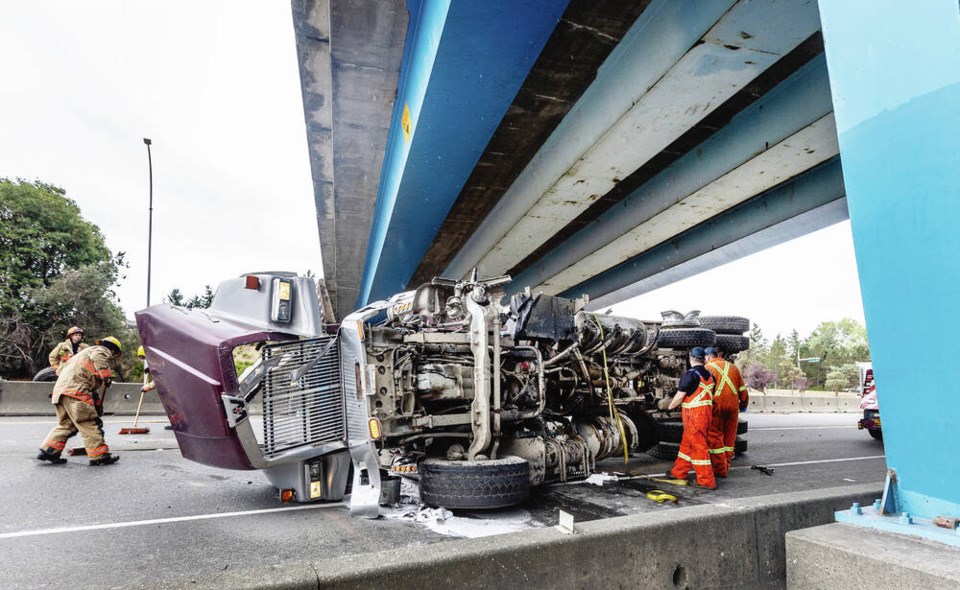The awful school-bus crash last week near 100 Mile House reminded me of how important it is to maintain your safety when suddenly coming across a crash scene.
I’m making no judgment around the death of a pedestrian, reportedly unconnected to the actual crash incident. The facts aren’t in yet. Assessing the scene and protecting yourself at a crash scene so that you can offer up meaningful assistance is the point.
When you come across a crash scene, particularly one where emergency responders have not arrived, your job is one of assessment and communication.
We all have limits around high-stress incidents. Having self-awareness about your physical and emotional stamina in saving another life is crucial. In B.C. you are not legally obligated to risk your life to save someone if your own life is endangered. Nor are you liable for a failed attempt at lifesaving.
No one should expect another to scale a steep cliff, plunge into a burning car or dive into a river to save someone if it’s beyond your personal capability. Heroes appear at many of these horrific incidents and act — but they have, consciously or unconsciously, made an assessment they can do something.
If you are held back by doubts around your own abilities, then your role is still equally important — you communicate and get help.
This is often difficult for untrained people who can panic themselves upon being the first on scene. Crash scenes are dangerous territory. But try to keep a few things in mind.
Is it safe to stop? Many accidents occur in bad weather with limited visibility. Try to position your vehicle away from danger and constantly keep your head on a swivel looking for approaching vehicles.
If it’s safe, position your vehicle, with hazard lights on, to protect victims who may be down on the roadway. Try and remember to keep a pathway open, if possible, for those emergency vehicles that are on their way.
Be aware of fire hazards, shattered glass or chemical spills. If you’re wearing flip-flops it might be better that another person approach the scene while you make the vitally important emergency call. If a vehicle has crashed through a roadside barrier, don’t be tempted to climb over yourself to have a better look. Another difficult rescue is the last thing first responders need.
I won’t offer advice about what to do if occupants are trapped in a vehicle and at risk of fire or drowning. That’s an assessment that must be made on scene based on what I’ve just discussed. At minimum, call for help and if there’s no cell signal, direct someone else to make contact with first responders, then report back to you.
I’m not going to offer first aid advice either, but emergency dispatchers will want to know immediately if victims are conscious and breathing. It is vital you remain calm and listen to their direction. These first few moments with critical injuries are the most important.
There’s some vital pieces of information dispatchers will need. Screaming at them to come quicker won’t accomplish anything. Instead scan the scene and answer their questions. They will want to know: how many people are injured and the extent of those injuries; how many vehicles are involved; is there fire or toxic substances present; and, very importantly, your exact location.
Often we come across these scenes when other people have also stopped to assist. If there are a number of people already on scene and clearly involved in providing help then you’re best to move on slowly and carefully. Stopping in the middle of the road to “check in” or at worst rubbernecking can create more danger.
There are often reports of secondary crashes at these types of events because drivers lose focus of their environment or don’t exercise nearly enough caution when driving through. If you see something that concerns you at a crash site which is already being well attended, then make a physical or mental note of the problem and contact the department or detachment involved later.
On longer road trips I always recommend that you carry a first aid kit, a high visibility vest, a flashlight, a blanket and a fire extinguisher. Most newer vehicles have a mapping or GPS system, which can be crucial in telling emergency services where you are. If your vehicle is not equipped for that, then work on keeping a mental note of things like: How far am I from the last town? What was the name of that river we just crossed? Or, what is a landmark that people will quickly recognize?
Staying calm, protecting yourself and being a reliable information source is often the best way to help crash victims when they need you the most.



